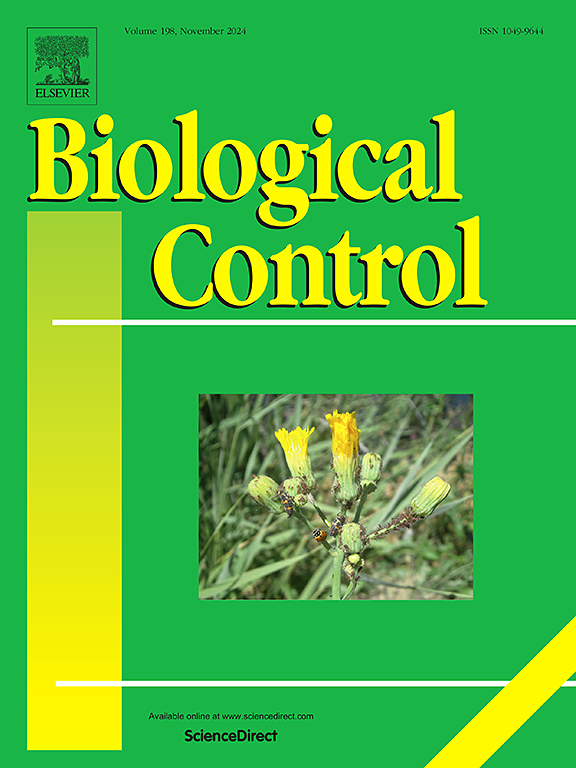球孢白僵菌防治斑蝇自接种装置的优化及效果研究
IF 3.4
2区 农林科学
Q2 BIOTECHNOLOGY & APPLIED MICROBIOLOGY
引用次数: 0
摘要
叶螨是危害多种农业和观赏作物的重要害虫。其对多种杀虫剂的抗药性阻碍了防治工作。本研究的目的是开发和优化一种专门用于防治紫斑夜蛾的自接种装置,并评价该装置在田间应用的效果。初始阶段包括筛选鉴定一株球孢白僵菌(Balsamo-Crivelli) Vuillemin菌株,该菌株对L. sativae具有高毒力。筛选出最佳菌种后,优化诱虫剂配方,优化装置设计,使诱虫率和感染率达到最大。然后进行了短期和长期的田间试验,以评估该装置在控制害虫种群方面的有效性。结果表明,球孢白僵菌XJWLMQ-1菌株对目标叶螨产孢子率、侵染率和致死率最高;以0.8 g/L浓度的反式-2-己烯醛、顺式-3-己烯醇、1-辛烯-3-醇、顺式-3-己烯乙酸酯和α-离子酮按4:1:1:3:1的比例混合引诱剂效果最佳。引诱剂放置在距真菌孢子20 cm、距豇豆冠层20 cm处效果最佳。短期和长期试验均证实了该自接种装置对黄斑夜蛾种群的控制效果,提示了其在目标害虫生物防治中的有效应用。本文章由计算机程序翻译,如有差异,请以英文原文为准。
Optimization and efficacy of an autoinoculation device for managing Liriomyza sativae with Beauveria bassiana
The leafminer Liriomyza sativae Blanchard (Diptera: Agromyzidae) is a significant pest damaging various agricultural and ornamental crops. Control is hindered by its resistance to multiple insecticides. This study aimed to develop and optimize an autoinoculation device specifically for controlling L. sativae and to assess the device’s efficacy in field applications. The initial phase involved screening to identify a strain of Beauveria bassiana (Balsamo-Crivelli) Vuillemin that was highly virulent to L. sativae. After selection of the optimal strain, the attractant formulation was refined and the device design was optimized to maximize pest attraction and infection rates. Short- and long-term field trials were then conducted to evaluate the device’s effectiveness in the control of pest populations. Results showed that the XJWLMQ-1 strain of B. bassiana had the highest rates of spore production, pest infection, and lethality to the targeted leafminer. The most effective attractant was a blend of trans-2-hexenal, cis-3-hexenol, 1-octen-3-ol, cis-3-hexenyl acetate, and α-ionone in a 4:1:1:3:1 ratio at 0.8 g/L concentration. Optimal efficacy was achieved by positioning the attractant 20 cm from the fungal spores and 20 cm above the cowpea canopy. Both short- and long-term trials confirmed that the autoinoculation device was effective in controlling L. sativae populations, suggesting its effective use for biological control of the target pest.
求助全文
通过发布文献求助,成功后即可免费获取论文全文。
去求助
来源期刊

Biological Control
生物-昆虫学
CiteScore
7.40
自引率
7.10%
发文量
220
审稿时长
63 days
期刊介绍:
Biological control is an environmentally sound and effective means of reducing or mitigating pests and pest effects through the use of natural enemies. The aim of Biological Control is to promote this science and technology through publication of original research articles and reviews of research and theory. The journal devotes a section to reports on biotechnologies dealing with the elucidation and use of genes or gene products for the enhancement of biological control agents.
The journal encompasses biological control of viral, microbial, nematode, insect, mite, weed, and vertebrate pests in agriculture, aquatic, forest, natural resource, stored product, and urban environments. Biological control of arthropod pests of human and domestic animals is also included. Ecological, molecular, and biotechnological approaches to the understanding of biological control are welcome.
 求助内容:
求助内容: 应助结果提醒方式:
应助结果提醒方式:


